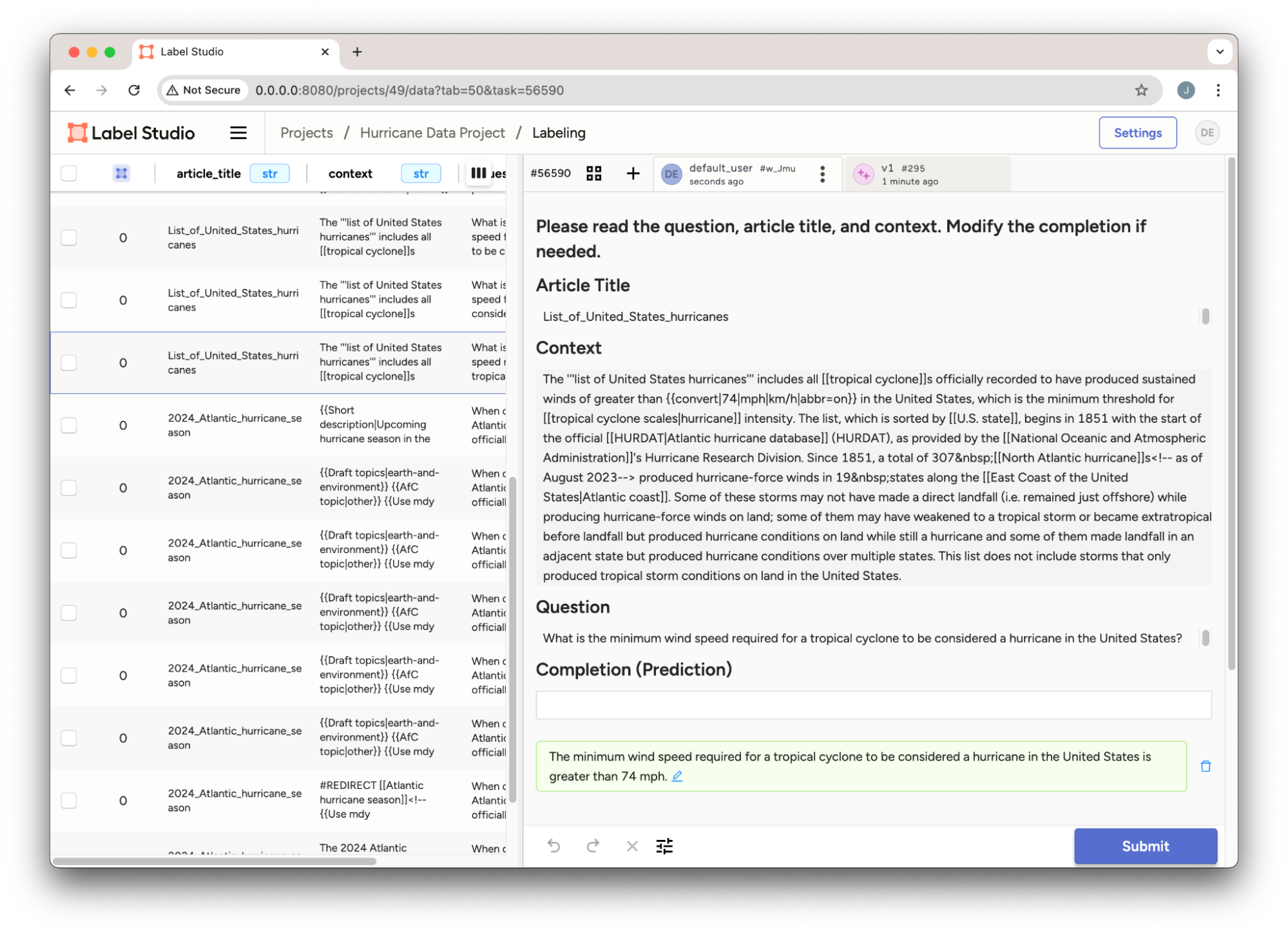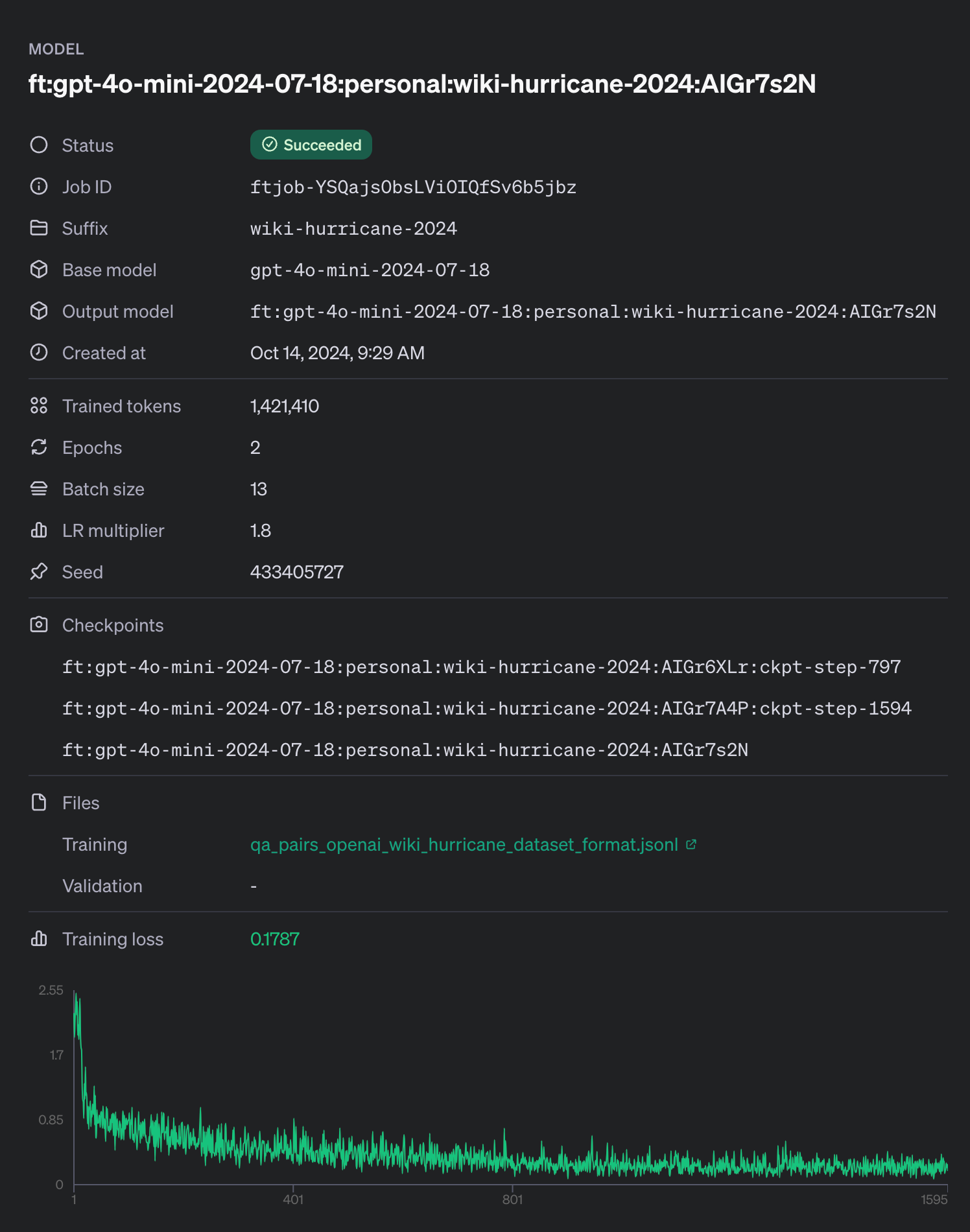微调OpenAI模型:基于维基百科数据的指南

微调大型语言模型(LLMs)是根据特定需求定制AI的强大方法。借助OpenAI的新微调功能,您可以使用领域特定数据、指令甚至自定义格式来调整他们的模型。这意味着您无需不断调整提示词就能获得更准确、相关的响应,最终降低成本并提高效率。
在本指南中,我们将带您完整了解OpenAI平台上的微调流程——从数据准备到成本估算,再到部署微调后的模型。如果您之前阅读过我们关于微调Llama 3模型的文章,本文会采用相似的思路,但重点介绍OpenAI的工具,并通过最新的维基百科数据展示一个实际案例。
微调及其适用场景
微调大型语言模型(LLM)意味着继续使用新的特定数据对其进行训练,使您能够针对特定任务或领域塑造其响应。这种方法让您可以基于模型已有的广泛知识,同时教会它处理更专业的内容。
以OpenAI的GPT-4o模型为例——它具有高度通用性,适用于广泛任务。但就像任何通用工具一样,它也存在局限。例如,其训练数据截止于2023年9月,因此无法知晓此后信息。您可能还会发现,该模型需要冗长复杂的提示词才能精准满足需求,这会因token消耗而推高使用成本。
微调可以帮助克服这些挑战,但并不总是正确的选择。以下情况适合进行微调:
- 您有一个包含特定提示词和期望输出的数据集。
- 您需要模型始终遵循某种格式——无论是结构化报告还是进行API调用。
- 您希望缩短提示词的长度并降低成本。
- 您拥有特定领域的数据需要整合,从而避免昂贵的检索增强生成(RAG)工作流程。
在本指南中,我们将向您展示如何利用维基百科的最新更新来微调模型。如果您想深入了解完整代码,可以在我们的示例代码库中找到相关笔记本。
数据整理与准备
为了演示微调过程,我们将使用一个真实世界的数据集——维基百科上最新的飓风数据更新。这个数据集非常适合,原因有两点:首先,由于模型的知识截止于2023年9月,这些时效性信息是模型未曾接触过的;其次,这让我们有机会针对一个非常具体且重要的话题(飓风)来微调模型处理新信息的能力。我们的目标是确保模型能够基于最新数据生成准确、最新的响应。下面我们将逐步介绍数据准备过程。
- 收集数据: 从选定的维基百科页面获取最新修订版本。
- 生成问答对: 将原始飓风数据转化为一组实用的问答对。
- 创建微调数据集: 将数据集格式化为符合OpenAI微调要求的格式。
收集数据
我们首先定义包含飓风相关信息的维基百科页面列表。这可能包括特定风暴的文章,如飓风米尔顿,或更广泛的主题,如2024年大西洋飓风季。通过从这些页面获取最新修订版本,我们确保输入模型的数据是最新的,并且未包含在其原始训练集中。
# List of relevant topics
topics = [
"List_of_United_States_hurricanes",
"2024_Atlantic_hurricane_season",
"Hurricane_Milton",
"Hurricane_Beryl",
"Hurricane_Francine",
"Hurricane_Helene",
"Hurricane_Isaac"
]这一过程的关键部分是确定一个日期范围——具体来说,我们将重点关注模型2023年9月知识截止日期之后所做的更新。这确保了模型不会已经"知道"我们用于微调的数据。一旦我们收集了所有必要的更新,我们将继续创建训练集。
def get_wikipedia_revisions(article_title, start_date):
...
def fetch_revisions_for_topics(topics, start_date):
"""Fetches revisions for all topics after a certain date and returns a combined dataset."""
full_dataset = [] # List to hold data for all topics
for topic in topics:
try:
print(f"Fetching revisions for {topic} starting from {start_date}...")
topic_data = get_wikipedia_revisions(topic, start_date)
full_dataset.extend(topic_data) # Append the data for each topic to the full dataset
except Exception as e:
print(f"Error fetching revisions for {topic}: {str(e)}")
return full_dataset # Return the full dataset
# Specify the start date (ISO 8601 format)
start_date = "2023-09-01T00:00:00Z"
# Fetch the latest revisions for all topics and store them in a dataset
dataset = fetch_revisions_for_topics(topics, start_date)如果您对获取维基百科修订版本的详细代码感兴趣,可以查看我们这里链接的笔记本。
生成问答对
收集到新数据后,下一步是将其格式化为模型可以有效学习的形式。一个非常有效的方法是生成问答对(Q&A)。为什么?因为这种格式高度模拟了模型在实际应用中的使用场景——无论是回答客户查询、处理常见问题,还是根据提示提供信息。
例如,给定新的飓风数据,我们可以生成类似“飓风米尔顿何时袭击美国?”这样的问题,然后根据维基百科的更新提供相应的答案。虽然手动创建这些问答对会非常耗时且容易出错,但我们可以利用OpenAI的现有能力,直接从维基百科修订版本中自动生成它们。
一个特别有用的功能是结构化输出,它能确保生成的答案遵循一致的格式。这一点很重要,因为它使得在流程的下一阶段处理数据变得更加容易。如果您想了解更多关于如何有效使用结构化输出的信息,我们撰写了一篇详细的博客文章,您可以点击这里查看。
from openai import OpenAI
from pydantic import BaseModel
from typing import List, Literal
import json
# Define the Pydantic model for the output format
class QAItem(BaseModel):
prompt: str
completion: str
class QADataset(BaseModel):
dataset: List[QAItem]
def generate_qa_pairs_from_changes(new_content, article_title):
"""
Query OpenAI to analyze the new content and generate a set of question-answer pairs.
If substantial information changes are detected (such as new sections, significant updates, or meaningful additions of facts),
the function returns a list of question-answer pairs in the specified JSON format.
"""
client = OpenAI()
# Create a query prompt to ask OpenAI to generate question-answer pairs based on the content
prompt = f"""
The following is newly added content to the Wikipedia article titled '{article_title}'.
Analyze the content and generate a set of specific question-answer pairs based on the new facts, updates, or meaningful changes.
Focus on creating general questions that a person might ask and answered them comprehensively with the content provided.
Do not ask questions that directly reference the date of the revision or the specific article title.
If a hurricane is mentioned, it should be referred to by its full name.
Ignore trivial changes such as typos or formatting.
Example questions:
- List the hurricanes that hit the US in 2024.
- What was the most recent hurricane to hit the US?
- What was the name of the hurricane that hit Florida in 2024?
- What was the category of hurricane Beryl?
- What was the path of hurricane Milton?
New Content:
\"\"\"{new_content[:3000]}\"\"\"
Please return a set of question-answer pairs in the form of a JSON array where each item is an object containing
'prompt' as the question and 'completion' as the direct answer from the content.
"""
try:
response = client.beta.chat.completions.parse(
model="gpt-4o-2024-08-06", # or "gpt-4o" if available
messages=[
{"role": "system", "content": "You are a helpful assistant that generates a set of specific question-answer pairs based on the new facts, updates, or meaningful changes Wikipedia articles."},
{"role": "user", "content": prompt}
],
max_tokens=1000,
temperature=0.7,
response_format=QADataset
)
return response.choices[0].message.content
except Exception as e:
return f"Error in generating QA pairs: {str(e)}"在我们整理好问答数据集后,可以查看生成的部分示例。
Number of examples in master_qa_list: 10362
{'prompt': 'When were shelters opened on the Caribbean islands due to Hurricane Beryl?', 'completion': 'Shelters were opened on June 29 on the Caribbean islands in response to Hurricane Beryl.'}
{'prompt': 'What measures were taken in Tobago in response to Hurricane Beryl?', 'completion': 'A state of emergency was declared for Tobago. Ferry schedules were modified on June 30, and all ferries to Tobago for July 1 were cancelled. Schools across the nation were also closed for July 1. Additionally, 145 people were sheltered in 14 shelters across Tobago.'}
{'prompt': 'How did Hurricane Beryl affect ferry operations in Trinidad and Tobago?', 'completion': 'Ferry schedules were modified on June 30, and all ferries to Tobago for July 1 were cancelled due to Hurricane Beryl.'}
{'prompt': 'How many people sought shelter in Tobago during Hurricane Beryl?', 'completion': '145 people sought shelter in 14 shelters across Tobago during Hurricane Beryl.'}在构建了一个强大的问答数据集后,仔细检查结果总是一个好主意。此时,我们可能需要人工审核员来验证问答对的准确性。我们将在Label Studio中创建一个项目来标注这个数据集。
from label_studio_sdk.client import LabelStudio
# Connect to the Label Studio API and check the connection
ls = LabelStudio(base_url=LABEL_STUDIO_URL, api_key=API_KEY)
label_config = """
Details in Notebook...
"""
# Create a new project
project = ls.projects.create(
title='Hurricane Data Project',
description='Label questions and completions about hurricanes with their respective contexts and titles.',
label_config=label_config
)
from label_studio_sdk.label_interface.objects import PredictionValue
for qa_pair in master_qa_list:
# Create task data
task_data = {
"data": {
"question": qa_pair['prompt'],
"article_title": qa_pair['article_title'],
"context": qa_pair['new_content']
}
}
# Create the task in Label Studio
task = ls.tasks.create(project=project.id, **task_data)
task_id = task.id
print(f"Task created with ID: {task_id}")
# Create prediction data
prediction = PredictionValue(
model_version="v1",
result=[
{
"from_name": "completion",
"to_name": "question",
"type": "textarea",
"value": {
"text": [qa_pair['completion']]
}
}
]
)
# Insert prediction into the task
ls.predictions.create(task=task_id, **prediction.model_dump())
print(f"Prediction added for task ID: {task_id}")将我们的数据插入项目后,我们查看带有预测生成的数据集,如图1所示。

图1:Label Studio中的飓风问答项目。
关于使用Label Studio SDK创建和设置项目的完整详情,请参阅示例笔记本。
创建微调数据集
准备好我们的问答数据集后,最后一步是为OpenAI的微调平台格式化数据。OpenAI要求使用特定的格式,称为jsonl聊天格式,其中每个交互包含一条系统消息、用户提示和助手的相应回复。这确保微调后的模型能理解如何以符合您用例的方式作出响应。
例如,这里有一个来自OpenAI微调文档的简化示例,展示了如何训练模型以略带讽刺的语气进行回应:
{"messages": [{"role": "system", "content": "Marv is a factual chatbot that is also sarcastic."}, {"role": "user", "content": "What's the capital of France?"}, {"role": "assistant", "content": "Paris, as if everyone doesn't know that already."}]}
{"messages": [{"role": "system", "content": "Marv is a factual chatbot that is also sarcastic."}, {"role": "user", "content": "Who wrote 'Romeo and Juliet'?"}, {"role": "assistant", "content": "Oh, just some guy named William Shakespeare. Ever heard of him?"}]}
{"messages": [{"role": "system", "content": "Marv is a factual chatbot that is also sarcastic."}, {"role": "user", "content": "How far is the Moon from Earth?"}, {"role": "assistant", "content": "Around 384,400 kilometers. Give or take a few, like that really matters."}]}在我们的案例中,我们需要调整问答数据结构以匹配该格式,将讽刺聊天机器人语境替换为更适合回答飓风相关问题的中立、有帮助的语气。完成后,数据集就可以进行微调了。
# System message for all entries
system_message = {"role": "system", "content": "You are a helpful assistant that answers questions about current events in hurricanes. Provide detailed answers."}
# List to store the converted dataset
new_format_dataset = []
# Convert each prompt-completion pair to the new format
for entry in master_qa_list:
new_entry = {
"messages": [
system_message,
{"role": "user", "content": entry['prompt']},
{"role": "assistant", "content": entry['completion']}
]
}
new_format_dataset.append(new_entry)微调
现在我们已经准备好了数据集,下一步是将其上传到OpenAI平台进行微调。这包括将数据写入文件,然后创建一个微调任务,使用格式化后的数据集来训练模型。
上传数据集
我们需要做的第一件事是将数据集上传到OpenAI。使用OpenAI的API非常简单,我们只需以正确的格式(`jsonl`)指定包含问答对的文件,并说明文件的用途——微调。
client.files.create(
file=open("qa_pairs_openai_wiki_hurricane_dataset_format.jsonl", "rb"),
purpose="fine-tune"
)文件上传后,您将收到包含文件元数据的响应。其中一个关键信息是文件ID,我们在开始实际微调任务时需要引用它。您应该会看到类似以下的输出:
FileObject(id='file-qBVnzhGrEHvEPvZg6ZwvTfpK', bytes=4301148, created_at=1728916096, filename='qa_pairs_openai_wiki_hurricane_dataset_format.jsonl', object='file', purpose='fine-tune', status='processed', status_details=None)这个ID(在本例中为`file-qBVnzhGrEHvEPvZg6ZwvTfpK`)就是我们创建微调任务时需要使用的标识符。
启动微调任务
文件上传完成后,我们就可以开始微调任务了。这一步需要告诉OpenAI您想要微调的模型、使用的数据集,还可以选择提供一个自定义后缀以便后续轻松识别。
在本例中,我们正在使用刚刚上传的飓风数据对模型`gpt-4o-mini-2024-07-18`进行微调:
client.fine_tuning.jobs.create(
training_file="file-qBVnzhGrEHvEPvZg6ZwvTfpK",
model="gpt-4o-mini-2024-07-18",
suffix="wiki-hurricane-2024"
)监控微调过程
创建任务后,您可以通过OpenAI仪表板或API跟踪其进度。图1展示了我们将在微调页面中看到的内容。我们可以监控微调任务的状态,或者等待电子邮件通知我们任务完成或出现错误的情况。

图2:基于我们飓风数据集的OpenAI微调详情。
在本示例中,我们未包含验证数据集。验证集可用于确保模型不会对训练数据产生过拟合,使习得的知识具有泛化能力(例如仅回答被明确提出的问题,而非相似问题)。
微调时间与成本
需要注意的是,微调模型并非即时完成——根据模型大小和数据集复杂度的不同,可能需要一定时间。与较小模型相比,像GPT-4o这样的大型模型自然需要更多处理能力和时间。同样,包含数千条详细条目的数据集,其微调耗时也会比规模较小、更聚焦的示例集更长。
除了时间因素,微调还会带来成本,因此合理规划预算至关重要。OpenAI的收费基于微调过程中使用的token数量以及所使用的模型类型等因素。为了帮助管理这些成本,OpenAI提供了在整个过程中跟踪token使用情况和费用的工具,使您能够优化微调工作流程并避免不必要的开支。我们在示例笔记本中包含了一些这类工具,它们将提供如下统计信息:
Dataset has ~736249 tokens that will be charged for during training
By default, you'll train for 2 epochs on this dataset
By default, you'll be charged for ~1472498 tokens如需了解具体价格和更多详情,请查看OpenAI的定价页面。
使用微调后的模型
微调过程完成后,您就可以像使用OpenAI的其他模型一样开始使用新定制化的模型。关键优势在于该模型现已针对您的特定用例进行了专门优化——在我们的示例中,即根据最新的维基百科更新回答有关近期飓风的问题。
要与微调后的模型交互,我们使用OpenAI的API,并指定刚训练模型的唯一标识符。在本例中,微调模型名为`ft:gpt-4o-mini-2024-07-18:personal:wiki-hurricane-2024:AIGr7s2N`。以下是一个简单示例,展示如何使用微调模型获取关于飓风米尔顿的信息:
from openai import OpenAI
client = OpenAI()
completion = client.beta.chat.completions.parse(
model="ft:gpt-4o-mini-2024-07-18:personal:wiki-hurricane-2024:AIGr7s2N",
messages=[
{"role": "system", "content": "You are a helpful assistant that answers questions about current events in hurricanes. Provide detailed answers."},
{"role": "user", "content": "When did Hurricane Milton hit the US?"}
]
)
print(completion.choices[0].message)在这个示例中,模型使用针对飓风微调过的数据来回答关于飓风米尔顿的具体问题。结果应反映我们在微调过程中包含的最新信息:
The most recent hurricane to hit the US in 2024 is Hurricane Milton, which struck Florida on October 9.此回复展示了模型现在如何"掌握"了在微调之前无法获取的最新信息。您现在可以将此模型用于类似查询,或将其集成到需要实时了解您特定领域当前动态的应用程序中,例如聊天机器人。
需要注意的是,虽然模型现在已针对您的需求进行了调整,但使用各种输入进行测试仍然至关重要。这有助于确保模型始终输出预期结果,并在不同场景下表现良好。这通常是一个迭代过程,需要不断优化数据集和后续的微调工作,以获得理想的结果。
如果您希望将这个微调后的模型集成到Label Studio中,可以通过Label Studio ML Backend轻松实现,特别是LLM Interactive Example功能。只需将`OPENAI_MODEL`参数设置为您的微调模型名称,即可利用该模型根据新提示生成预测结果。这能通过让模型协助重新生成预测或支持其他标注项目,帮助您简化标注流程。
结论
微调是一种强大的工具,可用于定制AI模型,使其在特定场景下以最少的人工干预实现更精准的表现。OpenAI平台简化了微调流程,降低了配置的复杂性,让您能专注于整理高质量数据。无论是提升聊天机器人性能还是生成定制内容,微调都能显著增强模型在真实场景中的表现。
如果您有兴趣将大型语言模型(LLM)集成到生成式AI工作流中,请务必查看企业版功能Prompts。Prompts提供了一种灵活的方式,可将这些先进的AI功能集成到您的项目中,从而简化整个组织内的标注和决策等任务。


